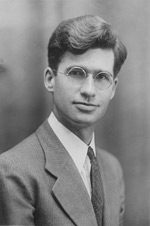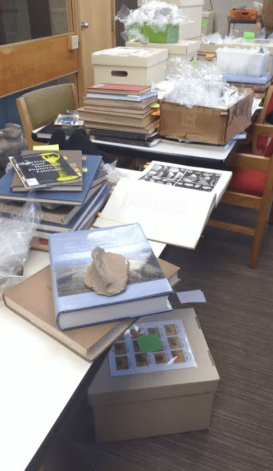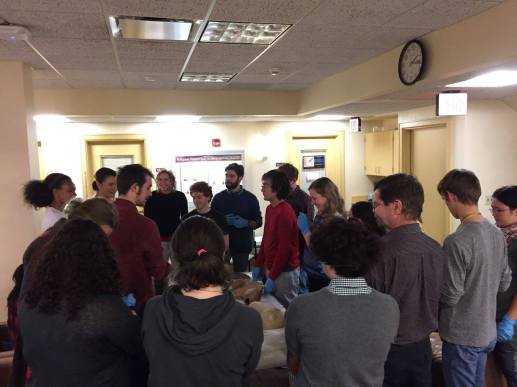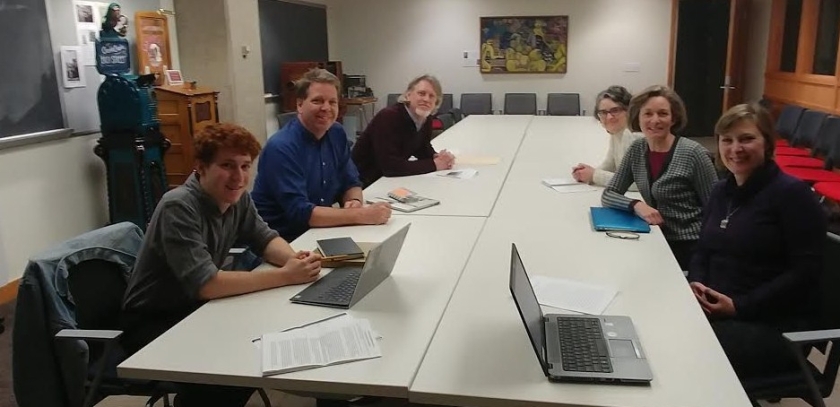Oberlin student Julian Hirsch (OC ’20) contributed the following essay that details the history of one of the college’s most important dangling collections, an assemblage of archaeological materials from the Near East that is housed in Oberlin’s Religion Department. Julian is now leading an energetic effort by fellow students, faculty, staff, and others to revitalize the Herbert G. May collection and make it more accessible for teaching and student research.
Introduction
The Herbert G. May Near East Study Collection, named after former Oberlin College religion professor Herbert May (taught 1934-1966, 1970-1973), encompasses a wide variety of archaeological material (mainly pottery) from the Southern Levant (Israel, Palestinian Territories, Jordan). Representing a vast time span ranging from the Pottery Neolithic (6500 B.C.E) to the Byzantine Period (640 C.E) the collection served to tie the Biblical texts which Oberlin students studied, first in the Theological Seminary and later in the Religion Department, to the material culture of the ‘Holy Land.’ This tying together of history, archaeology, and Biblical text was a popular scholarly practice for much of the late 19th and 20th centuries and served as the impetus for Oberlin and many other institutions’ acquisitions of these sorts of educational collections.
Today, the collection contains roughly 200 complete objects as well as about 500 individual pottery sherds. The material includes several complete pottery vessels, lithic materials, ground-stone objects, metal objects, carbonized seeds, Roman glass, Roman building material, various impressions of cylinder seals, and some miniature replicas of artifacts from the wider Near East. While most objects are authentic, some are facsimiles as identified by Dr. Jodi Magness in 2012.
Acquisition and History of the Collection
The material which today makes up the Herbert May collection was acquired from numerous sources and by several key figures between c. 1870 and 1980. In 1880 William Gaye Ballantine was hired at Oberlin College as a Professor of the Old Testament. Prior to his time at the college in the 1870’s, Ballantine had served as part of the American led Palestine Exploration which mapped out and recorded Biblically relevant archaeological sites on the western side of the Jordan River. Although not certain due to a lack of proper recording and accession, it is likely that a portion of the pottery sherds and vessels in the May Collection come from Ballantine’s travels.
Following the initial introduction of large-scale excavations to the ‘Holy Land’ in the 1890’s, archaeological interest in the region bloomed as several institutions began establishing their own digs. The year 1900 saw the founding of the American Schools of Oriental Research (ASOR) and an accompanying research center in Jerusalem that continues to operate today as the Albright Institute of Archaeological Research. During the 1914-1915 academic year, Oberlin’s then Professor of Old Testament, Kemper Fullerton (taught 1904-1934), was meant to serve as a Fellow at this research institution. His time there though was cut short due to the outbreak of the First World War. Despite this, preceding his evacuation from then Ottoman Palestine in December of 1914, Fullerton had the opportunity to visit various local historical sites and several excavations which were being undertaken at the time. It is likely that some of the material in the Herbert May Collection comes from Fullerton’s travels and acquisitions.
In 1919 Oberlin’s then President, Henry Churchill King, was invited by U.S. President Woodrow Wilson to survey the holy land with the intention of gathering information from local peoples to facilitate the smooth establishment of the post-war mandatory system that divvied up much of the region between the Britain and France. It is entirely likely that King acquired a limited volume of material which he brought back to the College and which was later incorporated in the Herbert May Collection.
The inter-war Mandatory Period (1922-1939) is widely regarded as the golden age of archaeological excavation in the southern Levant due to the sheer number of large-scale, well-funded, excavation projects which were undertaken simultaneously. One such project was at Megiddo, the Biblical site of Armageddon. During the 1920’s and early 1930’s Herbert G. May, who was then a PhD student in Theology at the University of Chicago served as the site’s photographer. In addition to his site photographs, May also took pictures during his travels throughout the region. These 3,000 photographs converted to slides today make up the Oberlin special collection’s H.G. May Archaeology of Palestine Collection. In addition to his photographs, Herbert May collected pottery vessels and sherds from various sites throughout mandatory Palestine. Some of these materials were given to him as gifts, as in the case of the material from Megiddo, while other material was likely purchased in antique shops in Jerusalem.

Courtesy of Oberlin
College Archives
Herbert G. May was hired by Oberlin in 1935 in order to serve as Kemper Fullerton’s replacement at Oberlin’s Theological Seminary. He brought along with him his collection of slides and photographs as well his collection of archaeological objects. These materials were used as a teaching aid in classes about the Old Testament. Some of this material was on display in a lecture hall often used by May in the Peters building where it remained at least until 1973 when Herbert May passed away.
The final additions to the Herbert May Collection were acquired by May’s successor, Harry Thomas Frank. Though Frank was not an archaeologist, he was passionate about the subject and was instrumental both in the establishment of Oberlin’s excavation at Tel-el Hesi in Israel in 1970 and Oberlin’s acquisition of an Early Bronze I (3700-3100 B.C.E) burial assemblage from the site of Bab-edh Drah located in modern day Jordan. This tomb group, comprised of 14 pottery vessels, arrived at the college in 1980 by which point Harry Thomas Frank had passed away. With no one to curate the collection, the Bab-edh-Drah material was placed into religion department storage along with the rest of the Herbert May collection. In 2002 and 2003, coinciding with the 50th anniversary of Oberlin’s religion department, the Bab edh-Drah tomb group was exhibited in Mudd Library. The objects soon after returned to storage where they have remained since.

Following her hiring in the early 2000’s, Oberlin’s current Professor of the Old and New Testament, Dr. Cindy Chapman, led an initiative to significantly improve the storage conditions of the Herbert May Collection. To facilitate this, archival storage boxes and humidity controlled cabinets were purchased to house the collection and to display a limited portion of it. In 2009, Professor Chapman mentored Dr. Craig Tyson (D’Youville College) as part of his CRLT mentorship program while he was then a graduate student at University of Michigan. Dr. Tyson worked with an undergraduate student to photograph and accession a portion of the collection. This represented the first major effort made to organize the collection and to make it more accessible.
In 2012, Dr. Jodi Magness (UNC Chapel Hill), a classical archaeologist specializing in the Southern Levant, came to give the Religion Department’s annual Haskell lectures. During her time at Oberlin, she had the opportunity to assess the collection. Magness concluded that the collection contained no completely unique artifacts and that its best use would therefore be as a resource for future students and their learning.
Professor Chapman most recently facilitated the most recent efforts to organize and catalog the Herbert May Collection by sponsoring a Winter Term project devoted to that goal which took place in January of 2017. The work done during this Winter Term project laid the foundation for the current efforts being made by Julian Hirsch to further organize the collection.
Today, only two boxes of material from the collection are in active classroom use. Professor Chapman incorporates a box of varied Roman material into an Introductory course about the New Testament and uses a box containing Late Bronze and Iron Age material for her course about the Old Testament and its Near Eastern context.
Attempts to Organize the Collection Pre-January 2017 Winter Term
The 2009 accession project undertaken by an undergraduate student and Dr. Craig Tyson produced a system of accession numbers as well as a certain number of object photographs. The accession system they developed is referred to as the HMC (Herbert May Collection) system. Presently, this accession numbering system is still in use for most of the collection’s complete objects. This system relies on a primary category number (1=Pottery, 2=Lamps, 3=Replicas and Writing, 4=Metal) along with ascending secondary numbers to differentiate each object within the categories.
Although this organizational system provided many of the objects with accession numbers, a great number of smaller items including the collection’s entire group of pottery sherds, were left unnumbered and were left without any sort of organization besides being placed in large quantities into uncategorized cardboard boxes. While some photographs were taken, the digital files for these photographs have since been lost leaving behind only printed thumbnail sized photographs. Unfortunately, no effort was made at that time to digitize the collection or to make it accessible online.
In recent years, interest on Oberlin’s campus has significantly grown with regards to the digitization, preservation, and recordation of many of Oberlin’s unused, historical teaching collections. This growing interest led Professor Cindy Chapman to organize a Winter Term project in 2017 with the goal of better documenting the Herbert G. May Near East Study Collection.
Winter Term January 2017
In January 2017, Professor Cindy Chapman sponsored a group Winter Term Project titled ‘Practicum in Curating Archaeological Pottery.’ In order to facilitate the program and help students on a day to day basis, veteran Levantine Archaeologist and Oberlin alumnus, Dr. Jeffery Blakely (University of Madison, Wisconsin) kindly took up residence at the college for the month. Professor of Anthropology Amy Margaris also assisted as she provided guidance to the Winter Term students during their creation of an object database. The nine students who participated in the project were: Samuel Chapin, Bryton Smith, Rayna Solbeck, Walter Campbell, Haley Jones, Elizabeth Altier, Maria Altier, Nalin Beckman, and Julian Hirsch.

Throughout the month the participants worked to create a database which would contain the totality of objects in the of the Herbert May Collection. This database was created in Excel and includes categories for object numbers, box numbers, current object locations, object types, material, and when possible, the object’s period, and site of origin. The document also contains a comments section that when possible includes a transcription of descriptive 3×5 index cards which Herbert May created for some of the objects.
Early on during the month, it was decided for simplicity’s sake that already existing object numbers would not be replaced by a new accession numbering system. Rather, a secondary accession system was created whereby artifacts without existing HMC numbers would simply be assigned an ascending number as its new identity. Part of the group’s decision to use this simple system as opposed to something resembling the HMC numbering put in place in 2009 was that this system did not require collection specific knowledge to understand. At the start of the January 2017 Winter Term, the various sub-category meanings for the HMC collection had been forgotten and therefore needed to be deciphered. It was decided that a simple system was advantageous since it could be easily understood without having to be deciphered.
Throughout the Winter Term, the group worked together to enter data into the database, create accession numbers and identify what could be said about individual objects through consultation with both Dr. Blakely as well as through guided research using archaeological publications and library materials.

Each student also participated in object photography using the Oberlin College Archive’s photography apparatus guided by Oberlin’s Visual Resources Collection Curator, Heath Patten.
This was a two-person process wherein one student would take digital photographs using a computer while another would be responsible for positioning the object and lights to minimize shadow. In order to give the entire group a chance to participate in all the necessary tasks, the various jobs were traded around so that everybody could get a feel for the different types of steps which go into the creation of an object database.
In addition to the group work undertaken during the winter term, each student also had the opportunity to undertake personal research projects using the parts of the Herbert May Collection which interested them most. These projects encompassed a wide array of subjects including pottery from the different periods represented in the collection, lithics, and cylinder seal impressions.

Ultimately, every student who participated in the Winter Term project learned a great deal about the material culture and history of the Southern Levant. The group effort led to a great deal of collaboration and mutual interest as students engaged with and shared updates on their individual research projects. By the end of Winter Term each student developed an understanding of the history of Oberlin’s participation in Levantine Archaeology. The research undertaken by students was stored on a hard drive along with the database which was produced during the month. While this database contains every single object in the collection, it would benefit greatly from a degree of standardization as well as some additional research.
The Herbert G. May Near East Study Collection Today and Future Directions
Despite the great progress was made on the Herbert G. May Near East Study Collection during the January 2017 Winter Term, more work still needs to be done to facilitate its organization and digitization. While some of the collection was photographed during Winter Term, these photos were of varying quality and were unstandardized in their lighting, angles, and formats. Good quality edited photographs will be essential to future collection accessibility. Further, although the database created during the winter term period will serve as a fine foundation, it would benefit greatly from additional categories such as weights and measurements as well as additional research into likely periods of temporal origin for many artifacts.
The January Winter Term undoubtedly increased the visibility of the collection on campus. Over the past two semesters alone, The Oberlin Archaeology Society, a student run archaeology club, has used the collection for two separate object handling workshops. These well attended events have allowed for over 30 Oberlin students to personally handle artifacts as well as to learn about their origins and the material culture of the Southern Levant.


More recently, Julian Hirsch has reinitiated work on the collection. He is currently organizing an effort made up of several students, faculty, and staff to digitize the collection with the eventual goal of making the objects visible online and increasing campus engagement with the collection. It is his greatest hope that these artifacts will one day find themselves in use in numerous courses taught by several departments.
While the Herbert May Collection is still to some extent dangling, it has great potential which is now starting to be exploited.

A Note on Sources: All historical information in the first section comes directly from a talk given by Dr. Jeffery Blakely to the Oberlin Archaeology Society on March 4th, 2017. Much of the rest is recounted from the author’s personal notes taken during January 2017, notes taken by the January 2017 group to record their day to day proceedings, and from the author’s personal recollections. Other dates are taken from Dr. Craig Tyson’s c.v. or from Professor Cindy Chapman’s list of Archaeologically Related Activities in Biblical Studies from her time at Oberlin.
About the Author
Julian Hirsch is a rising Junior at Oberlin College majoring in Classical Civilizations and Archaeological Studies. He became interested in the Herbert May Collection when he participated in the January 2017 Winter Term project and has since helped to facilitate the collection’s use by the Oberlin Archaeology Society. He is currently in the process of restarting organizational work on the Collection and hopes to digitize it by the time of his graduation. You can read about Julian’s archaeology related activities at his blog https://trowelsarefun.wordpress.com/.
